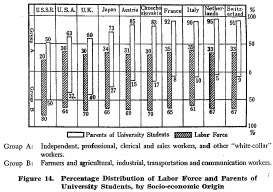| Home > Policy > White Paper, Notice, Announcement > White Paper > JAPAN'S GROWTH AND EDUCATION 1963 > CHAPTER |
||
The socio-economic origins of students enrolled in the higher educational institutions of a country are indicative of the socio-economic status of the country. As previously shown, higher education in Japan originated in a need for trained leadership. As the country became modernized, the increasing need for leadership resulted in the opening of the universities to the general public, and this trend was accelerated by the modern industrialization and democratization of Japan. However, although higher education is available to all students demonstrating the requisite scholastic ability, many families are unable to finance the costs of higher education even for capable students.
For comparative purposes, the distribution of the enrollment in higher educational institutions, together with the distribution of the total labor force of a selected group of countries is shown in Figure 14, with parents and workers divided between the groups generally referred to as "white-collar" workers and "laborers", respectively.

Figure 14 shows that in each country, except in the USSR, the percentage of students from group A, or so-called "white-collar" or intellectual class, is higher than that of those from group B, or "laborers" class, such as agricultural and industrial workers. Further examination of the chart indicates that these countries may be grouped according to similarity in the percentage of students from the so-called "laborers" class. Thus, the U.S.S.R., the United States and the United Kingdom form one group, with the highest percentage of students from this class; France, Italy, the Netherlands and Switzerland form a second group, with the lowest percentages of students from this class; and Austria and Chechoslovakia fall between these groups.
While reliable data of this sort are not available for Japan, it is estimated that 73 per cent of students in Japanese higher institutions are from the "white-collar" class, 27 per cent from the "laborers" class.
Thus, while in Japan opportunities and desire for higher education are more wide-spread that in the European countries, dissemination of higher education is more restricted in Japan than in the U.S.S.R., the U.S.A. and the United Kingdom. The reasons for the latter fact are largely if not entirely economic rather than social.
This calls for the expansion of scholarship system to meet the present day requirements to give opportunity for higher education to the students from all social strata for the development of human ability.
| Back to Top | MEXT HOME |